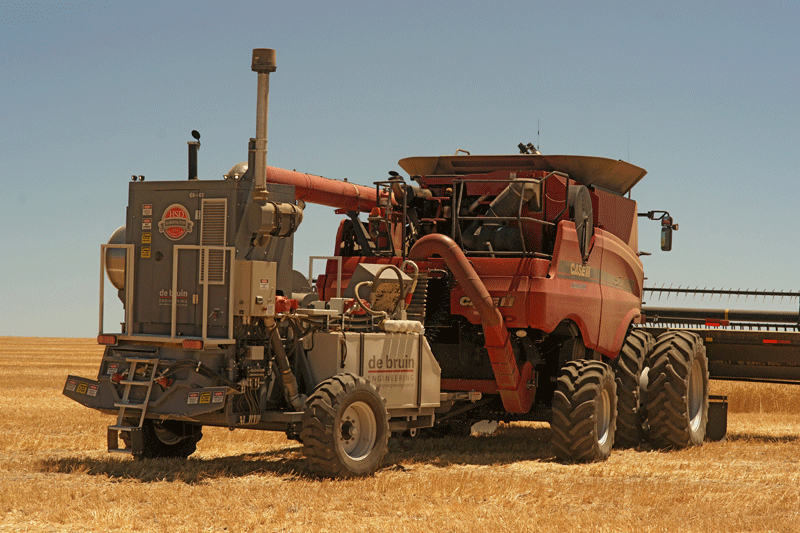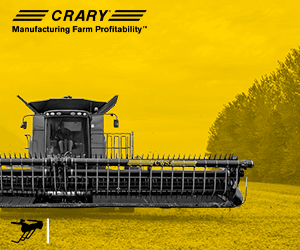Harvest weed management
HARRINGTON SEED DESTRUCTOR
IT IS COMMON practice for Ontario grain farmers to utilize herbicides to control weed populations in their fields. But as each year passes, common weeds are showing resistance to popular herbicides. This resistance has prompted further investigation into other methods of weed seed management by researchers and farmers alike, some of whom are looking to their international counterparts for advice.

According to the Australian government’s Department of Agriculture and Food, 25 weed species in Australia currently have populations that are resistant to at least one herbicide mode-of-action group. It has prompted many farmers there to implement their own harvest weed seed management practices to combat high resistance levels.
Three innovative farmers from Western Australia joined Dr. Michael Walsh of the Australian Herbicide Resistance Initiative on a cross North American tour to share knowledge of successful harvest weed seed management practices currently in place in their country. A stop was made at the Greenhouse and Processing Crops Research Centre in Harrow at the end of August. The demonstration event was open to researchers, media, farmers, and the general public. Of particular interest to attendees was the presentation given by Ray Harrington, developer of the Harrington Seed Destructor.
FINDING A SOLUTION
Harrington’s motto is “if you’ve got a problem, you fix it.” With 50 years of agriculture innovation, he has eleven products on the market while still cash cropping full time on his 5,000 acre farm near Darkan, West Australia.
Harrington has dealt with weed resistance in several of his crops, including wheat, lupins, and canola since selling his sheep flock in 1996. As the problem worsened, Harrington considered several methods of harvest weed management such as chaff carts and burning. However, at the time, chaff carts were still quite inefficient and expensive, and burning was not ideal for Harrington’s operation.
After considering catching, carting, cremating, and cooking weed seeds at harvest, Harrington decided that crushing would be the most successful against herbicide resistant weed seeds and he started to build his machine.
The Harrington Seed Destructor’s design is based on coal mining technology that was used to crush stone. Two cage mills, a small one placed within a larger one, run in opposite directions. With the combined speed and force, the cage mill is able to smash the weed seed ensuring the seed’s inability to germinate in the field.
The first round of field testing in 2007 proved to be successful; 95 per cent of annual ryegrass was eliminated. With these encouraging results, De Bruin Engineering was selected to manufacture the Harrington Seed Destructor. Rigorous testing has led to several improvements and the prototype now manufactured includes its own engine, hydraulics, and wireless sensor capabilities. They are also now working on a design to integrate the seed destructor machine directly onto the back of a combine. This new model is still in the research stage.
Harrington has partnered with Australia’s Grains Research and Development Corporation (GRDC), who is providing research and funding in order to continue improving the Harrington Seed Destructor.
“We haven’t beat it, herbicide resistance isn’t going away, but we are managing the issue,” says Harrington.
He welcomed the chance to speak to Ontario farmers because Agriculture & Agri-Food Canada (AAFC) purchased his machine after representatives attended the Global Herbicide Conference in Perth, Australia. He believes it shows Canada is taking a proactive stance towards weed resistance issues.
CANADIAN RESEARCH
The AAFC research project is a national initiative including researchers across Canada. The cost of the machine is about $200,000 and it will be tested on Ontario, Saskatchewan, and Alberta fields during the 2015 harvest. The prototype purchased for the study can be towed behind any make and model of combine, an added benefit for integrating into existing operations in Ontario.
The main goal of the research is to test the machine’s ability to destroy glyphosate resistant weeds including giant ragweed, common ragweed, Canada fleabane, and kochia.
Another major concern to be investigated is how the technology will deal with harvesting high moisture crops. Moisture levels are not a factor in Western Australia as many of the crops are grown with less than five inches of rain from planting to harvest.
“We know that it is an excellent fit for small grain crops,” Dr. Eric Page, a researcher with AAFC explains. “However, it remains untested with soybean crop residues in eastern Canada. All three weed species that are resistant to glyphosate have been found in soybean crops”.
Finally, Ontario farmers generally do not have equivalent field sizes as those in Western Australia. Turning a combine around in a small field is difficult even without a tow behind machine. A tow behind Harrington Seed Destructor could be impossible to maneuver in some areas.
To conclude his presentation, Harrington spoke directly to the farmers in the room: “If you aren’t burning, bashing, or burying your weed seeds, you aren’t going to be farming as long as I am. You’re out of the game”. It was a dire warning given his experience with weed resistance, but one that also came with a hopeful reminder that through innovation and cooperation, farmers can learn from each other within a global community.
It is unknown when the Harrington Seed Destructor will be available for purchase by Ontario farmers. More information on the machine can be found at http://www.ahri. uwa.edu.au.
CHAFF CARTS
Chaff carts are a harvest weed seed management tool being used by farmers in Western Australia to control herbicide resistant weed seeds.
Originally a Canadian design manufactured by Redekop Manufacturing in Saskatchewan, a chaff cart is an implement that is towed behind the combine. It was brought to Western Australia 30 years ago and has been used ever since. The cart collects the chaff from the combine, and once filled, it dumps it into a pile. The chaff in these piles can then be burned or can be baled for feed or bedding.
Australian farmer Lance Turner shared his experience with chaff carts at a presentation in Harrow in August. Turner has modified his carts to better collect chaff by replacing the original blower system with an elevator delivery system. Turner also designed his cart so that chaff is separated from the straw to be able to maintain some organic matter on his fields.
Herbicides are still actively used on Turner’s operation; however, the integration of chaff carts adds extra insurance that most weed seeds will be unable to germinate during the following planting season. Turner has found about 95% of his cropland has low weed seed numbers, especially annual ryegrass, a particularly aggressive, resistant weed. •








